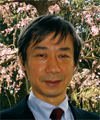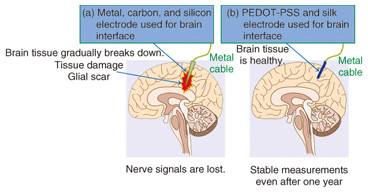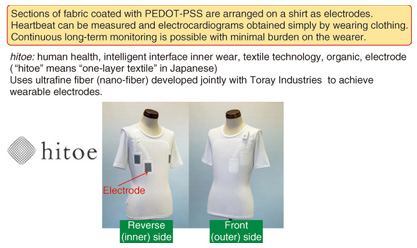 |
|
|
|
|
|
Front-line Researchers Vol. 12, No. 6, pp. 1–6, June 2014. https://doi.org/10.53829/ntr201406fr1  Advance with the Conviction that All Paths—Even Detours—Lead to SuccessThe Molecular and Bio Science Research Group has fabricated material for use as biomedical electrodes to continuously measure heartbeat and obtain electrocardiograms by simply wearing an item of clothing. Dr. Shingo Tsukada, a medical doctor-turned-researcher and an NTT Senior Distinguished Researcher in this group, expects hitoe, a textile developed jointly with Toray Industries, Inc. that incorporates these electrodes, to be useful in detecting latent diseases early. We asked him about the mindset that modern researchers should adopt and how the development of a healthy body can promote creative thinking in research. Keywords: biomedical electrodes, nano-bio interface, PEDOT-PSS Biomedical electrodes conceived from a doctor’s clinical experience—Dr. Tsukada, please tell us about your current area of research. Biotechnology is a field that has been researched at NTT laboratories since the 1980s. Today, the Molecular and Bio Science Research Group here at NTT Basic Research Laboratories is conducting research on nano-bio devices aimed at developing bio-compatible interfaces with the human brain. The wearable electrodes that we have developed for obtaining electrocardiograms originate in material that we originally used as ultra-small electrodes for recording fine signals generated by nerve cells in the brain. We now apply this material to ordinary-sized biomedical electrodes that can be attached to a person’s skin. Upon entering NTT, I became aware of a conductive polymer called PEDOT-PSS (Poly(3,4-ethylenedioxythiophene) polystyrene sulfonate), which I thought had great potential as a material for biomedical electrodes thanks to its flexible, biocompatible, and hydrophilic characteristics (Fig. 1). PEDOT-PSS, however, is quite fragile when wet, and in our initial experiments, prototypes easily broke down, resulting in a string of failures.
—What ideas led to the development of the wearable electrode? It all began with research to find ways of supplementing damaged nerves (neural prosthesis) by using a type of ultra-small electrode that can be inserted into the brain. The traditional approach in regenerative medicine, which makes use of genes and stem cells, is to stretch the axonal fibers of a severed central nerve to reconstruct the nerve circuit. From a technical viewpoint, this approach can be very difficult, so the idea came to me that perhaps the severed location could be functionally repaired by bridging and connecting the gap electronically. This method requires the passing of electrical signals by piercing the brain with an electrode in the form of a thin needle. However, metallic needles that had been used up to that time lacked flexibility and caused inflammation and a gradual breakdown of brain tissue in the area where the electrode was inserted. Solving this problem would require a highly flexible and biocompatible material that would be a good fit for the flexible and highly fragile tissue making up the brain. It was then that I came up with a method of coating silk threads used in surgical procedures with conductive PEDOT-PSS. Specifically, we were able to fabricate a strong, string-like composite material using a fiber such as silk as a base material. We then performed experiments with animals using this material as an electrode, and found that it could be used to make stable, long-term recordings of nerve signals (Fig. 2).
Through my experience as a doctor in clinical medicine, I became acutely aware of the need for a biomedical electrode that could be continuously connected with minimal burden on the patient. We used this fiber material to fabricate electrodes that can be attached to the surface of the skin, thereby bringing about hitoe (single-layer) wearable-electrode material. This electrode material does not attach to the skin in an air-tight manner, which makes it comfortable to wear with little chance of skin rashes. hitoe can therefore be used to obtain long-term biomedical recordings such as electrocardiograms (Fig. 3).
The present stage is only one part of a process toward accomplishing our final objectives. In the next step, I would like to conduct a long-term investigation into nerve functions using this conductive fiber. Recent research has shown that abnormalities in nerve functions for regulating blood vessels and the heart can lead to hypertension and heart diseases. An ideal approach to clarify the mechanisms of such conditions would be to use the hitoe material to research everyday behavior in people’s lives while conducting parallel experiments on nerve activity using implanted electrodes in animals. To date, no electrodes have been applied to long-term use, so research in this area has not been progressing as I would like, but hitoe should make such long-term research a reality. —How do you expect this research achievement to affect our everyday life in the future? I would like to expand the use of this electrode material to medical care. For example, I can envision a system that uses hitoe to record a person’s biological signals in everyday life and then checks for unhealthy signs that can be used to detect a potential disease or reduce the risk of a heart attack, for example. I am also investigating the application of hitoe to joint research on human cognition and behavior between NTT laboratories and universities. For example, regular exercise is an important element in maintaining a person’s health, but there are growing concerns that people—especially the young—are exercising less. One reason why people may be reluctant to exercise or engage in sports is a feeling that they are not especially good at it. Perhaps hitoe can be used to overcome this negative attitude. We have found that an athlete’s biological signals recorded using hitoe contain interesting information that cannot be obtained from video images. It might therefore be possible to use the biological signals collected while a skilled sportsman is exercising as guidelines or teaching material in individual instruction. If hitoe can be used to help people quickly develop exercise skills, I think there is a good chance that these people will develop a love of exercising and will naturally increase the amount of exercise they do. The need to “reset” by talking with friends in other fields and by sleeping and exercising—When exactly do you have such original ideas? When conversing with friends not only in my field but in completely different fields, such as theater arts and video production, I am always reminded how other people can have ideas or a sense of life completely different from my own, and that can be very stimulating for me. Ideas also come to me when I am involved in outside activities such as listening to music or exercising. In particular, a very positive and forward-looking feeling arises within me when I am exercising. Although my career has had many twists and turns, I have been able to surmount any hardships I have had thanks to the presence of my friends and my love of exercise. During my research activities in the United States, I came to feel that Japanese people are somewhat pessimistic on the whole. Resetting your body by taking on a positive and bright attitude, sleeping well, and exercising should help you come up with novel ideas and original points of view. —That sounds like good advice from a doctor. By the way, you have a very unique background. Why did you decide to make the switch from a medical doctor to a researcher? I attribute that to my father, who was an employee of Nippon Telegraph and Telephone Public Corporation. As a child, I made many visits to Kanto Teishin Hospital in Gotanda, Tokyo, which was originally founded for NTT employees. It was there that I developed an interest in the work of doctors. I also had an interest in machines and electronic components when I was small, and I became adept at building electronic kits and fiddling with mechanical assemblies using a soldering iron, thanks to my father’s guidance. Then, when I was in high school, I began to worry over which career path to take: doctor or researcher in a technical field. After much wavering between the two, I finally chose to become a doctor, and since I had been somewhat dexterous with my fingers since childhood, I decided to make use of that skill by becoming a surgeon. I chose, in particular, microneurovascular surgery in which I would connect nerves or blood vessels while peering through a microscope. This would involve, for example, the sewing together of blood vessels about one millimeter in diameter using a needle with a special type of thread so that blood could circulate smoothly again. It would also mean the reconstruction of sensory nerves and motor nerves by connecting neural branches. It takes at least three years to acquire the skills to make such surgical connections, and during my initial training, I would look for spare time in between consultations with patients to practice those skills using small animals or other means. However, despite the skills that I finally acquired after much effort, I developed severe allergy symptoms on my hands and fingers due to the gloves and antiseptic solutions that are needed for surgery, and in the end, I had no choice but to abandon my plans to become a surgeon. Instead, I turned to basic medicine and began basic research in physiology and nerve reconstruction. Today, in the field of medicine, there is no theme more important than medical treatment related to the heart and brain. These two organs are difficult to regenerate, so if they fall into a serious state or are affected by disease, treatment becomes difficult. With this in mind, I decided that I wanted to pursue research into ways of curing such complex diseases. Twenty years ago, however, when I began my research, the research laboratory at the medical college that I attended was not fully equipped with the equipment and devices that I needed to carry out my experiments, and if a researcher cannot experiment, he cannot write papers. As a result, I followed the advice of my academic supervisor to “create whatever you need yourself” and succeeded in constructing research apparatus on my own. My research topic involved measuring the distribution of and change in the concentration of intracellular calcium within neurite extensions of neurons to be reconstructed in a special environment. I began constructing my equipment after purchasing the components that I needed in Akihabara, Tokyo’s electronic-supply district. For the expensive microscope and sensors, I gathered together the bare minimum of components and somehow managed to construct a device for measuring the concentration of calcium in neurons. In this way, I learned through my own experience that “no one but you can make it happen.” Incidentally, NTT Basic Research Laboratories, with which we were doing joint research at that time, was equipped with state-of-the-art equipment for the same application as the device that I constructed, so I thought, “Some day, I want to do research at an institution like that.” Additionally, my experience working in a research laboratory at the University of California San Diego in the United States continues to influence my research style. In that laboratory guided by a medical doctor, I was able to expand upon my clinical medicine oriented-basic research in neuroscience and generate a certain amount of results. I was engaged, in particular, in basic research on the treatment of Alzheimer’s disease and spinal cord injuries through a combination of gene therapy and stem cell transplants. It was here that I performed a successful experiment in stretching and reconnecting a severed central nerve. In this research, it took about five years from the time of this successful experiment to completing and submitting my paper. From this experience, I came to realize that it is difficult to treat the neural and cardiac diseases of patients, which is the objective of clinical medicine, solely by using techniques from molecular and cellular biology. I therefore resolved to enter NTT Basic Research Laboratories to search for a new method that could restore neural and cardiac functions and cure those diseases. NTT Basic Research Laboratories is a site where specialists from a wide variety of fields come together to perform research. The hitoe functional material was developed by successfully resolving key issues associated with water resistance, durability, and other characteristics through the collaboration of specialists in the chemistry and engineering fields and also by gaining technological cooperation from the textile manufacturer. The “Tsukada Way” born of ideas rooted in clinical practice—Much of your research seems to be based on your diverse experience and to be motivated by a feeling of necessity. Perhaps I am an unrefined researcher. I think that many researchers employ commercially available equipment and devices and carry out experiments efficiently according to established protocol. I, on the other hand, am the type to prepare the tools that I need in a trial-and-error manner and to carry out experiments in a somewhat probing manner while visualizing what would take place in an actual clinic. For example, I strive to uncover even minor issues that occur with the electrode material and to eliminate each and every problem. At first glance, this may seem to be a roundabout approach, but I consider it to be an important process. Of course, this takes time, and failures can occur frequently, and there are many tasks that I myself find troublesome, but it only takes one breakthrough to open up great possibilities toward discovering something new. It is also important that I get as many people as possible to understand what my research is all about. When I make a presentation, I try to prepare exhibits that portray something of what I actually do in my research. Perhaps I do this simply out of necessity, but I think it’s very important to “show and tell.” On the occasion of a recent NTT press release, I was called upon to prepare a communication terminal marked with the hitoe logo and to give a measurement demonstration in which a model was asked to wear the terminal. For the people attending this demonstration, seeing a real functioning device in this way stimulates their interest and makes them think about future possibilities. It’s important to arouse everyone’s imagination! Acting with a sense of flexibility—Dr. Tsukada, what kind of mindset should the modern researcher adopt? Can you leave us with some encouraging words for young researchers? Where do differences between a researcher and a doctor lie? First of all, a doctor works in proximity to patients, so not a day does go by without a doctor sensing what is needed in actual clinical practice. In contrast, a researcher has little opportunity to come into contact with actual users. Based on my past experience, I strive to apply the results I obtain from basic research to as many needs as possible in the real world. In addition, a doctor is obligated to explain specialized concepts in an easy-to-understand manner in order to gain consent for medical treatment. Now that I have become a researcher, I also make it a point to explain specialized technology in a manner that is as easy to understand as possible in terms familiar to the listener. The hitoe project has been progressing over a very short period of time, but I am conscious of the need to speed up decision making and actions even further. It is important that possibilities and problem areas be uncovered promptly and that appropriate measures be taken without delay. Basic research in the 20th century involved clear-cut goals, such as solving major problems or submitting one’s paper to high impact journals, and researchers were expected to produce results to achieve those goals. Now that we have entered the 21st century, major changes appear to be taking place in this regard. Today, young researchers are being asked to respond flexibly to the demands of the times, such as by taking up the challenge of solving latent problems in society. Structural problems in society lead to situations in which changes are difficult to deal with and things seem to go bad no matter what is done. Nevertheless, even under these conditions, I believe that we can learn something and grow. Current scientific research and development is becoming highly advanced and compartmentalized. From the user’s viewpoint, this is a time in which understanding what front-line researchers do is becoming difficult. Accordingly, while asking young researchers to continue their efforts in front-line, specialized research, I would at the same time ask them to be sensitive to the environment surrounding research today and to respond to major needs in society. Interviewee profileCareer highlightsShingo Tsukada received the M.D. Diploma and License from Toyama University in 1990, and the Ph.D. degree from the University of Tsukuba in 2003. He joined NTT Basic Research Laboratories as a Research Specialist in 2010 and has been in his present position since 2013. He is engaged in work on human-machine interfaces, including wearable electrodes and their systems, both in vivo and in vitro, especially in the neuroscience field. He is a member of the Japan Neuroscience Society (JNS), the Physiological Society of Japan, the Japanese Circulation Society, and the Society for Neuroscience. |



